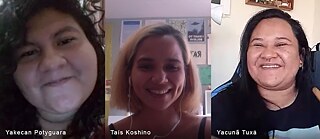Interview with Taís Koshino
In school, we learn about Indigenous peoples only when studying the Portuguese arrival

How did you find out about your story’s movement?
In the beginning of 2020, I was part of a project in which we were making illustrations of important Brazilian women in history. At one point as the project was developing, I realized that there were hardly any Indigenous women, so I decided to illustrate only them. I started to do research about these women and as I got deeper, I found out about the Indigenous LGBTQIA+ movement that is happening in Brazil.
Why does the world need to learn more about your story’s movement?
The Indigenous LGBTQIA+ Brazilian activism fights for the right of existence, for the right to be seen and understood as who they are, Indigenous and LGBTQIA+. The movement presents alternative ways of thinking about sexuality and gender at the same time that it exposes how the effects of colonialism, which still reverberate today, have historically oppressed and erased sexual and gender dissident practices.
What was the most surprising discovery you made during your research?
The most surprising discovery for me was to realize how much I didn’t know about Brazilian Indigenous history. In school, we learn about Indigenous peoples only when we are studying the Portuguese arrival around 1500. But they existed before and they continue to exist. They have a 521 year old history of struggle and resistance against colonialism and exploitation.
What gives you most pleasure while working on the project?
Being able to tell the international community about these women’s stories and the Brazilian Indigenous LGBTQIA+ activism with the hope that when more and more people know about it, the chance is greater that we can change it.
What did you learn from the workshops, mentorships, and other participants?
A lot! In the workshops, I was surprised when we shared our projects and realized that most Indigenous and original people from the Global South go through almost the exact same problems related to land and government recognition. In the workshops, Nacha and Amruta were extremely generous in sharing with us what is most important for them in narrative construction. The mentorship with Amruta was very important to me: she helped me develop my comic by posing questions and being very thoughtful about the feedback.
What aspect have you found most challenging during the process so far?
The responsibility of telling another person’s story was the most challenging aspect during the process. How to tell the story of someone whose community I am not a part of, in view of my life situation being more privileged. These are tricky issues. Being in contact and learning with the interviewees made me face a lot of my privileges.
How are you trying to give back to the community?
So far what I’ve done for them was to be able to pay the interviewees. Considering the Brazilian pandemic context, that’s already something. When the comic is released, I believe that will be the biggest give-back to the community, since then Brazilian Indigenous LGBTQIA+ will be able to read the comic and see someone like them being the protagonist, and more people will know more about their struggle.
What should ideally happen after the project’s publication?
I wish this project to reach the young and not so young Indigenous LGBTQIA+ so they can read it and diminish the feeling of being alone and wrong. Also, if the international community learns more about this specific activism, perhaps change will occur. Right now we can’t count on the Brazilian government to implement positive changes related to human rights. I hope that after the online book publication I can again secure funding to print the book in Portuguese and distribute it among Indigenous schools and libraries in Brazil.
What are your plans for the future?
It’s been quite hard to have plans for the future for me as a lesbian artist. Since 2019, with the Bolsonaro government, and now with the pandemic that has already surpassed 500,000 deaths in Brazil, the future is uncertain. But I hope that I can keep working on projects related to my art, aiming to amplify minority voices in order to generate change so people can be their true selves without suffering so many acts of violence.